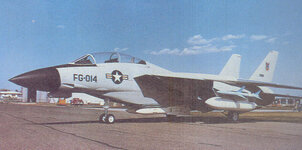I beg to differ.
Ask anyone who flew one...F-106 could wipe the floor with the F-4, any day of the week.
The reason the F-4 hung around longer than the F-106 was because advancing time and technology eventually developed superior Air Superiority aircraft, which was the F-106's primary, if not only, job.
The F-4 was seen as more of a "mule" that could be fitted with various munitions to carry out various jobs.
Versatility was the F-4's saving grace, but it was far from the "best fighter " of the 1960's.
Elvis
I don't have any neighbors that have driven anything beyond a bus or a boat, so, until proven otherwise I'll stick to my opinion that F-4 was the best fighter of the 1960s. It was good in doing the long-range interception, as well as in going tree-top killing the MiG-17s. Contrary to F-106, F-4 captured several world records in speed and time-to-alt categories, and was not trying to kill it's pilots that dared to eject. Always with the second pair of eyes, and fully navalized unless costumer wanted otherwise.
F-4 didn't needed saving grace.

